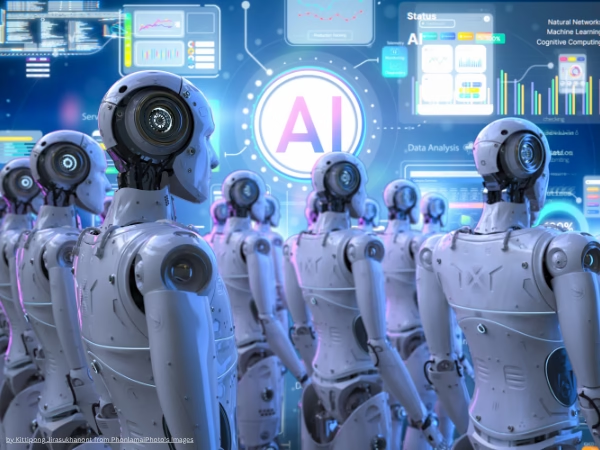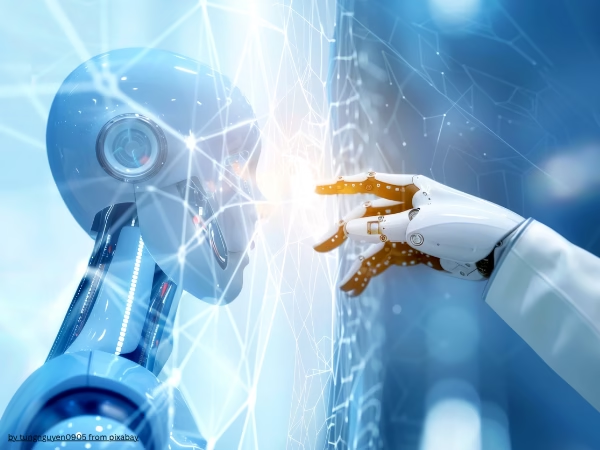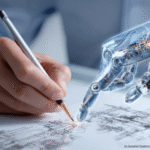Artificial Intelligence, or AI, has become a part of our everyday life. We see it when we unlock our phones with face recognition, when a website recommends a movie, or when a digital assistant answers our questions.
But how do these systems really work? To truly understand AI, we need to go deep and explain foundation of artificial intelligence, the ideas and systems that help machines learn, think, and act like humans.
This guide is written for school and college students who want to learn about AI in simple words. It will help you understand how AI began, what makes it intelligent, how it connects with other technologies, and why it matters in real life.
AI for Dummies
Artificial Intelligence is the study of how to make computers and machines that can think and act like people. It shows machines how to process data, make choices, and find solutions to problems. AI tries to make a system that can think like the human brain by using it as a model.
AI isn’t magic; it’s based on logic and learning. It starts with data, which is what a machine gets. AI then studies that data and learns from it using special instructions called algorithms. It gets smarter the more data it has.
This is what sets AI apart from regular computer programs. Software that isn’t smart just follows rules that people wrote. AI, on the other hand, can learn from examples and get better on its own.
If you want to understand this concept better, our post “Exploring Domains of AI (Artificial Intelligence)” explains how AI is divided into areas such as learning, reasoning, and perception. Each of these areas plays a key role in building the foundation of intelligence.
Basic Concepts of Artificial Intelligence
To explain foundation of artificial intelligence, we must first look at its basic concepts. Every AI system depends on a few important ideas that act like its building blocks.
AI uses data as its fuel. It needs large amounts of information to study and make predictions. Then comes algorithms, which are sets of steps that help AI understand and learn from data. These algorithms allow AI to look for patterns and make decisions. Another concept is learning, where the machine improves after every task, just like humans learn from experience.
AI also has the ability to reason, which means it can compare options and select the best answer. It can also perceive its surroundings using cameras, microphones, or sensors. These senses help AI to see, hear, and respond to the world.
If you are new to these ideas, our article “What is the Main Goal of Generative AI?” explains how AI systems are trained to learn creatively and produce new information on their own.
Key Elements of AI
When we explain foundation of artificial intelligence, we cannot skip its key elements. These elements form the structure that helps AI think and act intelligently.
One important element is Machine Learning (ML). This is a process that allows AI to learn from data without being told exactly what to do. If we give an AI system thousands of examples of cats and dogs, it will learn how to identify them on its own.
Another element is Neural Networks, which work like tiny digital brains. They help AI recognize speech, images, and handwriting. Then we have Natural Language Processing (NLP), which allows AI to understand and respond in human language. For example, when we type a question into a chatbot, NLP helps it understand what we mean and give a clear answer.
The fourth element is Computer Vision, which helps AI see and interpret images. This is how self-driving cars read traffic signs or detect people on the road. Finally, Robotics combines AI’s learning and reasoning with movement, creating machines that can perform physical actions.
These elements together form the solid base that supports all kinds of artificial intelligence. You can find more details about how these parts connect in “Exploring Domains of AI (Artificial Intelligence)” on our site.
What Are the Features of AI
AI has a lot of strong and useful features. The ability to learn, adapt, and make decisions are some of the most common features. AI systems can learn from their mistakes and do better by looking at the results and changing what they do.
Another thing is that it can be automated. AI can do the same thing over and over again without needing a break. It also works very quickly and accurately. Humans can make mistakes, but AI can quickly process large amounts of data and give the right answers if it is trained well.
AI can also figure things out in a logical way. It looks for patterns in big sets of data that people might miss. In short, AI is reliable, fast, and can work in almost any field, including healthcare, education, and more.
Our post “What is Artificial Intelligence Essay Writing?” explores how these same features help AI create written content in simple and clear ways.

What Are the Characteristics of Artificial Intelligence
When we discuss what are the characteristics of artificial intelligence, we talk about the qualities that make it intelligent. The most important characteristic is adaptability. AI can learn from new situations and change its behavior accordingly.
AI can also think logically. It can figure out problems and come up with logical solutions. Like a person, it can sense, understand, and do things. Another strong trait is perception. AI uses cameras and sensors to see the world and then turns that information into knowledge.
For example, in the article “What is AI Anchor? Explained in Simple Words,” you can see how AI systems are used in media to read news, recognize tone, and present information naturally, all because of these characteristics.
Basics of AI and Machine Learning
AI and Machine Learning are closely linked. In fact, ML is one of the most important tools that gives life to AI. The basics of AI and machine learning are easy to grasp if we imagine AI as the overall brain and ML as the learning method that trains it.
Machine learning lets a system learn from data and get better on its own. It learns by seeing and doing things, not by following orders. Supervised learning, unsupervised learning, and reinforcement learning are the three main types of learning. Each type helps AI get smarter by looking at data in different ways.
If you want to explore these ideas further, the post “Exploring Domains of AI (Artificial Intelligence)” explains how learning and reasoning form the base of intelligent systems.
Artificial Intelligence of Things
AI becomes even more powerful when it connects with the Internet of Things (IoT). This combination is called the Artificial Intelligence of Things or AIoT. It means devices that can collect data, think, and act on their own.
Think about a smartwatch that keeps track of your heart rate and sends you alerts if something seems wrong, or smart lights that turn off by themselves when no one is in the room. These are some real-life examples of AIoT. The AI part learns from what you do, and the IoT part connects devices to the internet.
This mix shows how AI’s base helps it work in the real world. Students can see how AI’s logic goes from computer programs to real-world systems that make life easier by understanding this. More such examples are shared in “What is the Main Goal of Generative AI?” where creative systems are also linked with daily use.
Artificial Intelligence Basics for Beginners
For students and beginners, learning AI might sound difficult. But the artificial intelligence basics for beginners are actually simple when explained step by step.
AI is all about teaching machines how to learn from data and perform human-like tasks. Anyone can start by understanding how AI reads, studies, and responds to information. You can begin by learning simple concepts such as algorithms and data sets.
If you prefer reading offline or collecting study material, many students use guides like Artificial Intelligence for Beginners PDF, which provide small lessons in easy language. For more practical steps, the post “How to Start with AI for Beginners” gives a clear learning path you can follow.
Understand AI and How It Works
To understand AI, imagine a machine as a student that never stops learning. Each time it receives information, it studies it carefully and gets better at predicting what comes next. The process starts with data, moves through learning, and ends with action.
When an AI system makes a mistake, it learns from that mistake and improves. This ability to self-correct is what makes AI so unique. It can solve problems faster than humans and even recognize things like voices, faces, or text patterns.
If you want to read about how AI learns to understand creative work, our post “What is Artificial Intelligence Essay Writing?” shares how AI uses language and logic to write like humans.
How to Learn Artificial Intelligence Step by Step
Learning AI is a journey that anyone can start. You do not need to be a computer scientist to take the first step. To learn artificial intelligence step by step, start with understanding how it works. Then, move to small experiments and simple projects.
First, learn the theory. Study what AI is and how it learns from data. Then, watch short tutorials or read beginner guides. After that, try using AI tools or websites that allow you to create basic models without coding.
Our article “Importance of AI in Education” also explains how AI is being used to support learning, showing why it is important for students to understand this subject now.
Importance of AI in Education
Education is one of the fields that shows the true value of AI’s foundation. Schools and universities use AI to make learning easier and more personal. AI can check homework, suggest study materials, and even teach languages through chatbots.
By using AI, students get feedback faster, and teachers save time on repetitive tasks. This helps both sides focus on creativity and understanding.
If you want to explore how AI changes the way people learn, our post “Importance of AI in Education” gives real examples from classrooms where AI is already improving education systems.
AI Basics and Everyday Life
When we talk about AI basics, we mean the simplest ideas that connect everything about artificial intelligence. These are the thoughts and methods that make all applications possible. AI basics include learning, problem-solving, and reasoning.
In everyday life, AI basics are everywhere. Smartphones use AI to predict text, cameras use it to detect smiles, and social media platforms use it to show content we like.
These examples prove that the foundation of AI is not just theory. It is already working quietly in the background of our daily routine. Students who understand this can see how small ideas build into big innovations.
How to Start with AI
If you are thinking about how to start with AI, begin small. Learn the theory first. Read simple guides and try free online courses. Many websites allow beginners to experiment with ready-made tools.
You can also look at real examples. For instance, the article “What is AI Anchor? Explained in Simple Words” shows how AI is used in media to present news. Examples like this make AI easier to imagine and understand.
The key is curiosity. Ask questions, read about new trends, and keep exploring. The more you learn, the clearer AI becomes.
Understanding AI in the Modern World
AI is no longer a topic for the future; it is part of our present. When we talk about understanding AI, we mean seeing how it connects to our lives. From education to medicine and entertainment, AI supports people everywhere.
The article “Exploring Domains of AI (Artificial Intelligence)” goes deeper into how AI divides into learning, reasoning, and perception. These domains form the true base of how machines think. Once you know these, you will start to see AI everywhere, in smart devices, cars, and even art.
By now, you should have a clear picture of how to explain foundation of artificial intelligence. It starts with simple logic, grows with data and learning, and touches almost every part of life.
The Future Built on AI’s Foundation
Explaining the foundation of Artificial Intelligence helps us understand how this technology has changed the world. It shows how machines can learn, reason, and solve problems in ways that help humans.
For students, learning about AI is not just about technology. It teaches how logic and creativity work together. It also opens new career paths in science, education, and design.
AI is built on simple yet strong ideas, data, learning, reasoning, and problem-solving. These ideas make it useful in everything from writing essays to creating new products.
If you want to explore more, check our posts “AI Topics for Presentation: Easy Ideas for Students”, and “25 AI and Machine Learning Interview Questions You Should Know” They show how the same foundation works in real life.
Artificial Intelligence will continue to grow, but its roots will always stay the same. The more we understand these roots, the better we can use AI to build a smart and creative future.
FAQs on Explain Foundation of Artificial Intelligence
Q1. What is the foundation of Artificial Intelligence?
The foundation of Artificial Intelligence is the basic system that helps machines think and learn. It includes data, logic, and learning methods that make AI act smart like humans.
Q2. What are the key elements of Artificial Intelligence?
The key elements of AI are machine learning, neural networks, natural language processing, and computer vision. These parts help AI understand information and make decisions.
Q3. What are the main features of AI?
The main features of AI are learning ability, automation, accuracy, adaptability, and speed. These make AI useful in education, media, and daily life.
Q4. How can a beginner learn Artificial Intelligence step by step?
A beginner can start by reading simple guides on AI basics, watching short tutorials, and using free AI tools. Then they can try small projects and move to online beginner courses.








